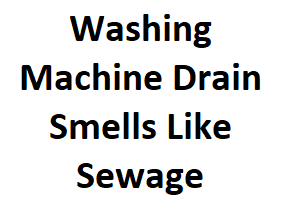A washing machine is an indispensable appliance in modern homes, streamlining the tedious chore of laundry. However, when an unpleasant sewage-like odor starts emanating from the washing machine drain, it can quickly become a frustrating and concerning issue. This blog post aims to delve into the root causes of this problem and provide effective solutions to eliminate the foul odor, ensuring a fresh and pleasant laundry experience.
Causes of a Sewage-like Smell
- Trapped Debris and Residue: Over time, debris such as lint, hair, soap scum, and even small articles of clothing can accumulate within the washing machine’s drain pipe. This buildup creates a breeding ground for bacteria and mold, leading to foul odors.
- Dry P-Trap: The P-trap is a curved section of pipe beneath the sink or washing machine that holds water to prevent sewer gases from escaping into the living space. If the washing machine drain’s P-trap dries out due to infrequent use, it can allow foul-smelling sewer gases to rise into the laundry area.
- Sewer Line Issues: A clogged or damaged sewer line can result in backups and unpleasant odors in the entire plumbing system, including the washing machine drain.
- Bacterial Growth: Bacteria and mold thrive in damp environments, such as the washing machine’s drain hose and the interior of the machine itself. This growth can produce a distinct sewage-like smell.
Fixes and Solutions
- Regular Cleaning and Maintenance:
- Run an empty hot water cycle with a cup of white vinegar or baking soda to dissolve residue and kill bacteria.
- Clean the lint filter and detergent dispenser regularly to prevent buildup.
- Inspect and clean the drain hose and P-trap periodically.
- Maintain Drain Trap Water Seal:
- Ensure the P-trap beneath the washing machine is regularly flushed with water by running the machine occasionally, even if not in use.
- Consider installing a P-trap primer, which automatically adds water to the P-trap to maintain the seal.
- Address Sewer Line Issues:
- If the smell persists throughout the house, contact a professional plumber to inspect and address any sewer line problems.
- Use Proper Detergents:
- Opt for low-sudsing, high-efficiency detergents to reduce soap scum buildup and prevent bacterial growth.
- Regular Maintenance Checks:
- Inspect and clean the washing machine’s drain hose, filter, and interior on a monthly basis to prevent odor-causing buildup.
Preventive Measures for Long-Term Odor Control
In addition to the immediate fixes and solutions mentioned above, adopting a few preventive measures can go a long way in maintaining a sewage-free washing machine drain:
- Proper Loading: Avoid overloading your washing machine, as excessive clothes can lead to incomplete drainage and cause odors to develop.
- Leave the Door Open: After completing a laundry cycle, leave the washing machine door and detergent dispenser drawer slightly open to allow air circulation and prevent moisture buildup.
- Use a Mesh Laundry Bag: Placing small items like socks and undergarments in a mesh laundry bag can prevent them from getting trapped in the drain and causing blockages.
- Regular Ventilation: Ensure that the laundry area is well-ventilated to minimize the chances of moisture accumulation and bacterial growth.
- Check for Leaks: Inspect the washing machine, hoses, and connections for any signs of leaks, as moisture can contribute to foul odors over time.
- Regular Plumbing Maintenance: Schedule routine plumbing inspections to identify and address potential issues before they escalate and lead to odors.
- Run Hot Water Cycles: Periodically running hot water cycles without any laundry or detergent can help dissolve accumulated soap scum and prevent bacterial growth.
- Avoid Chemical Overload: While occasional use of bleach can help disinfect and remove odors, excessive use can damage the machine and exacerbate the problem.
Professional Assistance
If you’ve tried the aforementioned fixes and preventive measures and the sewage-like smell persists, it may be time to seek professional assistance. A licensed plumber can perform a thorough inspection of your plumbing system, including the washing machine drain, to identify any hidden issues causing the odor. Professional expertise can ensure that the problem is properly diagnosed and resolved, providing you with peace of mind and a fresh-smelling laundry area.
Conclusion
Dealing with a washing machine drain that smells like sewage can be a frustrating experience, but with a proactive approach and the right maintenance techniques, you can successfully eliminate the odor and prevent it from recurring. By regularly cleaning your washing machine, maintaining the P-trap water seal, and adopting preventive measures, you’ll not only enjoy a pleasant laundry environment but also extend the lifespan of your washing machine. Remember, if the odor persists despite your efforts, don’t hesitate to enlist the help of a professional plumber to ensure a comprehensive and effective solution. With proper care and attention, you can keep your laundry area smelling fresh and clean, making laundry day a more enjoyable task.

